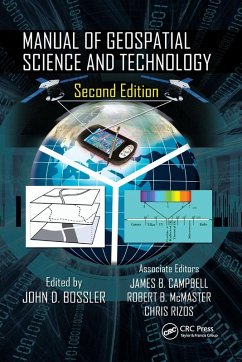Manual of Geospatial Science and Technology
Herausgeber: Bossler, John D; Mcmaster, Robert B; Campbell, James B
Manual of Geospatial Science and Technology
Herausgeber: Bossler, John D; Mcmaster, Robert B; Campbell, James B
- Broschiertes Buch
- Merkliste
- Auf die Merkliste
- Bewerten Bewerten
- Teilen
- Produkt teilen
- Produkterinnerung
- Produkterinnerung
Following in the tradition of its popular predecessor, the Manual of Geospatial Science and Technology, Second Edition continues to be the authoritative guide for setting up and managing GIS projects. Significantly updated and expanded to reflect advances in the technology, applications, and usage of the geospat
Andere Kunden interessierten sich auch für
![Green Aviation Green Aviation]() Green Aviation62,99 €
Green Aviation62,99 €![Essential Concepts of Bearing Technology Essential Concepts of Bearing Technology]() Tedric A HarrisEssential Concepts of Bearing Technology240,99 €
Tedric A HarrisEssential Concepts of Bearing Technology240,99 €![Essai Sur La Construction Navale Des Peuples Extra-Européens, (Éd.1841) Essai Sur La Construction Navale Des Peuples Extra-Européens, (Éd.1841)]() Edmond PârisEssai Sur La Construction Navale Des Peuples Extra-Européens, (Éd.1841)18,99 €
Edmond PârisEssai Sur La Construction Navale Des Peuples Extra-Européens, (Éd.1841)18,99 €![Prestressed Concrete Designer's Handbook Prestressed Concrete Designer's Handbook]() P W AbelesPrestressed Concrete Designer's Handbook176,99 €
P W AbelesPrestressed Concrete Designer's Handbook176,99 €![Oceanography and Marine Biology Oceanography and Marine Biology]() Oceanography and Marine Biology80,99 €
Oceanography and Marine Biology80,99 €![Matlab(r) Essentials Matlab(r) Essentials]() William BoberMatlab(r) Essentials176,99 €
William BoberMatlab(r) Essentials176,99 €![Hydraulic Canals Hydraulic Canals]() Jose Liria MontanesHydraulic Canals80,99 €
Jose Liria MontanesHydraulic Canals80,99 €-
-
-
Following in the tradition of its popular predecessor, the Manual of Geospatial Science and Technology, Second Edition continues to be the authoritative guide for setting up and managing GIS projects. Significantly updated and expanded to reflect advances in the technology, applications, and usage of the geospat
Produktdetails
- Produktdetails
- Verlag: Taylor & Francis Ltd (Sales)
- 2nd edition
- Seitenzahl: 856
- Erscheinungstermin: 30. September 2020
- Englisch
- Abmessung: 234mm x 156mm x 43mm
- Gewicht: 1175g
- ISBN-13: 9780367884215
- ISBN-10: 0367884216
- Artikelnr.: 60004344
- Herstellerkennzeichnung
- Libri GmbH
- Europaallee 1
- 36244 Bad Hersfeld
- gpsr@libri.de
- Verlag: Taylor & Francis Ltd (Sales)
- 2nd edition
- Seitenzahl: 856
- Erscheinungstermin: 30. September 2020
- Englisch
- Abmessung: 234mm x 156mm x 43mm
- Gewicht: 1175g
- ISBN-13: 9780367884215
- ISBN-10: 0367884216
- Artikelnr.: 60004344
- Herstellerkennzeichnung
- Libri GmbH
- Europaallee 1
- 36244 Bad Hersfeld
- gpsr@libri.de
John D. Bossler is a consultant and also Professor Emeritus at The Ohio State University, specializing in GIS, GPS, and remote sensing. He is retired from the positions of Professor and Director of the Center for Mapping at The Ohio State University, Columbus. Previously, he was director of both the National Geodetic Survey and the Coast and Geodetic Survey. He has authored over 100 papers in the fields mentioned.
Prerequisites. An Introduction to Geospatial Science and Technology.
Coordinates and Coordinate Systems. Datums and Geospatial Reference
Systems. Coordinate Transformations. Basic Electromagnetic Radiation. Data
Analysis. Global Positioning System. Introducing the Global Positioning
System. Fundamentals of GPS Signals and Data. GPS Positioning Models for
Single Point and Baseline Solutions. GPS Instrumentation Issues. Making
Sense of GNSS Techniques. GPS Projects: Some Planning Issues. Carrying Out
a GPS Surveying/Mapping Task. Servicing the GPS/GNSS User. GPS, GNSS, and
the Future. Remote Sensing Photogrammetry for Remote Sensing.
Remote-Sensing Analysis: From Project Design to Implementation.
Remote-Sensing Systems for Operational and Research Use. Information
Extraction from Remotely Sensed Data. Image Processing Software for Remote
Sensing. How to Assess the Accuracy of Maps Generated from Remotely Sensed
Data. Emerging Markets for Satellite and Aerial Imagery. Airborne LIDAR
Mapping. Selected Scientific Analyses and Practical Applications of Remote
Sensing: Examples from the Coast. Remote Sensing-A Look to the Future.
Geographic Information Systems. Geographic Information Systems and Science.
GIS Fundamentals. Geographic Data Structures. Spatial Analysis and
Modeling. Spatial Data Quality. Cartography and Visualization. Carrying Out
a GIS Project. Geographic Information Science and Society. Applications.
Biophysical and Human-Social Applications. Local Government Applications:
Toward E-Governance. Geographic Information Technology in State Governments
of the United States. National, International, and Global Activities in
Geospatial Science: Toward a
Coordinates and Coordinate Systems. Datums and Geospatial Reference
Systems. Coordinate Transformations. Basic Electromagnetic Radiation. Data
Analysis. Global Positioning System. Introducing the Global Positioning
System. Fundamentals of GPS Signals and Data. GPS Positioning Models for
Single Point and Baseline Solutions. GPS Instrumentation Issues. Making
Sense of GNSS Techniques. GPS Projects: Some Planning Issues. Carrying Out
a GPS Surveying/Mapping Task. Servicing the GPS/GNSS User. GPS, GNSS, and
the Future. Remote Sensing Photogrammetry for Remote Sensing.
Remote-Sensing Analysis: From Project Design to Implementation.
Remote-Sensing Systems for Operational and Research Use. Information
Extraction from Remotely Sensed Data. Image Processing Software for Remote
Sensing. How to Assess the Accuracy of Maps Generated from Remotely Sensed
Data. Emerging Markets for Satellite and Aerial Imagery. Airborne LIDAR
Mapping. Selected Scientific Analyses and Practical Applications of Remote
Sensing: Examples from the Coast. Remote Sensing-A Look to the Future.
Geographic Information Systems. Geographic Information Systems and Science.
GIS Fundamentals. Geographic Data Structures. Spatial Analysis and
Modeling. Spatial Data Quality. Cartography and Visualization. Carrying Out
a GIS Project. Geographic Information Science and Society. Applications.
Biophysical and Human-Social Applications. Local Government Applications:
Toward E-Governance. Geographic Information Technology in State Governments
of the United States. National, International, and Global Activities in
Geospatial Science: Toward a
Prerequisites. An Introduction to Geospatial Science and Technology.
Coordinates and Coordinate Systems. Datums and Geospatial Reference
Systems. Coordinate Transformations. Basic Electromagnetic Radiation. Data
Analysis. Global Positioning System. Introducing the Global Positioning
System. Fundamentals of GPS Signals and Data. GPS Positioning Models for
Single Point and Baseline Solutions. GPS Instrumentation Issues. Making
Sense of GNSS Techniques. GPS Projects: Some Planning Issues. Carrying Out
a GPS Surveying/Mapping Task. Servicing the GPS/GNSS User. GPS, GNSS, and
the Future. Remote Sensing Photogrammetry for Remote Sensing.
Remote-Sensing Analysis: From Project Design to Implementation.
Remote-Sensing Systems for Operational and Research Use. Information
Extraction from Remotely Sensed Data. Image Processing Software for Remote
Sensing. How to Assess the Accuracy of Maps Generated from Remotely Sensed
Data. Emerging Markets for Satellite and Aerial Imagery. Airborne LIDAR
Mapping. Selected Scientific Analyses and Practical Applications of Remote
Sensing: Examples from the Coast. Remote Sensing-A Look to the Future.
Geographic Information Systems. Geographic Information Systems and Science.
GIS Fundamentals. Geographic Data Structures. Spatial Analysis and
Modeling. Spatial Data Quality. Cartography and Visualization. Carrying Out
a GIS Project. Geographic Information Science and Society. Applications.
Biophysical and Human-Social Applications. Local Government Applications:
Toward E-Governance. Geographic Information Technology in State Governments
of the United States. National, International, and Global Activities in
Geospatial Science: Toward a
Coordinates and Coordinate Systems. Datums and Geospatial Reference
Systems. Coordinate Transformations. Basic Electromagnetic Radiation. Data
Analysis. Global Positioning System. Introducing the Global Positioning
System. Fundamentals of GPS Signals and Data. GPS Positioning Models for
Single Point and Baseline Solutions. GPS Instrumentation Issues. Making
Sense of GNSS Techniques. GPS Projects: Some Planning Issues. Carrying Out
a GPS Surveying/Mapping Task. Servicing the GPS/GNSS User. GPS, GNSS, and
the Future. Remote Sensing Photogrammetry for Remote Sensing.
Remote-Sensing Analysis: From Project Design to Implementation.
Remote-Sensing Systems for Operational and Research Use. Information
Extraction from Remotely Sensed Data. Image Processing Software for Remote
Sensing. How to Assess the Accuracy of Maps Generated from Remotely Sensed
Data. Emerging Markets for Satellite and Aerial Imagery. Airborne LIDAR
Mapping. Selected Scientific Analyses and Practical Applications of Remote
Sensing: Examples from the Coast. Remote Sensing-A Look to the Future.
Geographic Information Systems. Geographic Information Systems and Science.
GIS Fundamentals. Geographic Data Structures. Spatial Analysis and
Modeling. Spatial Data Quality. Cartography and Visualization. Carrying Out
a GIS Project. Geographic Information Science and Society. Applications.
Biophysical and Human-Social Applications. Local Government Applications:
Toward E-Governance. Geographic Information Technology in State Governments
of the United States. National, International, and Global Activities in
Geospatial Science: Toward a









